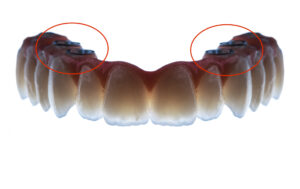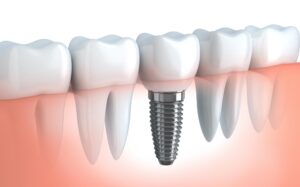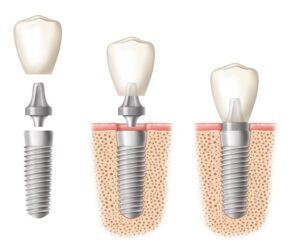Header logo
header top contact widget
All-On-4
Dental Implants Not ‘One Size Fits All’
Posted on Sep 21, 2021 by William J. Claiborne, DDS MS
A periodontist specializes in the diagnosis and placement of dental implants, in addition to the treatment of all stages of periodontal disease.
For people who are considering dental implants to replace teeth, this level of expertise provides greater reassurance of successful treatment outcomes. A periodontist can also offer patients with a wider choice of implant systems.
How can patients have more dental implant options through a periodontist?
When general dental offices offer dental implants, some general dentists offer implant selection and placement along with the restoration of the implant. (“Restoration” refers to the replacement crown that is attached to the implanted portion.)
Although generalists complete training in dental implants, most courses are offered by particular implant manufacturers. This means that the course focuses on the systems available through this one maker, which may or may not include the one most appropriate for your individual needs.
This is why most generalists refer the placement portion to a periodontal specialist. For their patient, this can mean a higher level of success, especially for complex needs.
For example, a patient who is missing a lot of bone mass (due to missing natural teeth for many years) benefits from the specialized skills of our Asheville periodontal office. A periodontist can incorporate bone rebuilding procedures into treatment to a proper depth. This specialist can help to restore bone that has occurred in the mandible (lower jaw) or maxilla (upper jaw), which may also require a sinus lift.
Another example is a patient who has lost teeth due to periodontal (gum) disease. Because a periodontist combines advanced skills in treating gum disease as well as in dental implants, these patients have an added advantage when it comes to treatment success.
For many reasons, dental implants have become the preferred tooth replacement option. There are over 40 different implant systems, each designed to accommodate various challenges and preferences. Some of the more common types include:
Traditional Dental Implants: In this process, dental implant treatments is done in a couple of stages. In the first stage, placement of each implant is performed. This involves small incisions in pre-selected placement points. In our Asheville periodontal dental office, these points are determined through computerized imaging, taking the guesswork out of the depth and angle of each implant placed. Once the implant is in proper position, the gum tissue is closed over the implant sites.

Several implants can often hold a full arch of teeth
The second stage involves a “healing period” of 3 – 6 months. During this phase, the bone grows around the implant(s) to secure each in place. The patient’s denture or partial denture can be comfortably worn during this time. This process is known as osseointegration, which describes the jaw bone growing around the implanted portion. This is what secures the implant so it provides stable, dependable biting and chewing strength.
After osseointegration is complete, the implant sites are uncovered and a post is positioned in the implant’s interior. Onto the posts, replacement teeth are attached. Once the final teeth are secured, patients can enjoy their confident smile along with the biting and chewing comfort like that of natural teeth.
Non-Removable Teeth Attached To Implants: In the past, the more affordable ‘full arch’ systems were typically those designed to support removable teeth. (An ‘arch’ is a full arrangement of all upper or all lower teeth.) However, some people feel removable teeth are too similar to the denture they wish to replace. Although firmly secured, the chore of having to remove teeth to clean them is a task many people want to eliminate.
A number of affordable implant systems are now available, designed to provide non-removable options that are more affordable. For example, the All On 4 dental implant system is made to support non-removable teeth on just 4 implants. With the implanted portions placed at unique angles, these longer implants can fully distribute biting and chewing forces. Another advantage of All On Four is their ability to be placed in minimal bone.
This is good news for people who are long-time denture wearers and were told they have too little bone to support implants. Or, they may have been advised to have bone grafts to rebuild the bone to an adequate height. This adds time and expense to implant treatment. Often, the All On 4 design is able to overcome this obstacle.
‘Same-Day’ Dental Implants: Advancements in dental implant systems and technology have evolved into implant placement and teeth attachment that can be accomplished in a single day. Some implant designs can position implants in the jaw bone in a way that they are able to support replacement teeth immediately.
With the replacement teeth created prior, the teeth may be attached without delay. In some cases, a previously-made denture or partial can be reconfigured to attach to newly placed implants. However, mounting replacement teeth to a just-placed implant isn’t wise for certain situations. This option should be diagnosed and performed by an experienced, skilled and highly-trained dental specialist in order to achieve a successful outcome. While “same-day” procedures can sound appealing, choose care where your individual needs are a priority.
Modern implant dentistry is successful, safe, dependable and can provide nearly immediate benefits. Our office enjoys a reputation for being on the cutting edge of implant dentistry’s techniques, technology and materials. This assures our patients of care that minimizes discomfort and treatment time while optimizing their final results.
Dental implants are designed to last a lifetime, making them an excellent investment. They are the closest thing to the natural teeth you once had, restoring the ability to bite, chew, speak and laugh confidently.
Over the years, I have been a witness to the transformations many implant patients undergo after treatment. They seem to smile and laugh more, become more social, and focus on their oral and overall health to a greater extent.
The type of dental implant best suited for you can be determined after an examination and review of x-rays (we use Cone-Beam digital imaging). Call 828-274-9440 to begin with a private, no obligation consultation to discuss your best options.
Please know that, if cost is a concern, payment plans can help you enjoy your beautifully restored smile while making easy monthly payments. Too, in many cases, an implant is not needed to replace each missing tooth. Often, when several teeth are missing in one area, one or two implants can support a “bridge” of several teeth. This curtails the treatment costs by reducing the number of implants needed.
If dental fear or anxiety is a concern, please mention this during our consultation. In our Asheville office, our entire team strives to provide a respectful, compassionate environment. We offer oral and I.V. sedation (twilight sleep) for nearly any procedure as well as a gentle touch at every visit.
Missing Teeth? Know The Ends-&-Outs of Dental Implants
Posted on Jan 29, 2021 by William J. Claiborne, DDS MS
 If you are one of the millions of adults who are missing one or more natural teeth, you are actually in the majority if you are over the age of 50.
If you are one of the millions of adults who are missing one or more natural teeth, you are actually in the majority if you are over the age of 50.
According to the Centers of Disease Control & Prevention (CDC), by the age of 50, Americans have lost an average of 12 teeth. For those between the ages of 50 to 64, over 10 percent have no remaining natural teeth. Twenty-six percent – more than one-fourth – of adults between 65 – 74, have lost ALL of their natural teeth.
Replacing natural teeth may seem simple. Often, people assume that a partial or bridge will solve the problem. Yet, these dental appliances merely worsen an already precarious situation. While these dental prosthetics “mimic” the appearance of teeth, what’s occurring beneath the gum line has a significant impact on what’s to come.
To understand the rocky road in the future, consider the foundation of natural teeth – the jaw bone.
The reason biting and chewing occurs dependably and with stability with natural teeth is because they are secured by the jaw bone. When natural teeth are removed, their roots are no longer present in the jaw bone. The presence of these roots actually provides stimulation to the jaw bone, which helps to preserve the bone’s mass. Without this stimulation, the bone resorbs, a process of which bone mass “melts away”.
Resorption is to blame for dentures or partials that start to move or slip over time, even though the fit was snug when first made. Because resorption reduces bone height, the ridge the denture was contoured to fit begins to flatten. A shrinking ridge leaves the denture with an insufficient base.
The pace of bone loss speeds up a little more each year. The pressure of a denture on the ridge accelerates the rate. For people who sleep in their dentures or partials, the continual pressure ramps up the pace further.
As the ridge flattens, denture adhesives or pastes become of little help while trying to eat. This leads many denture wearers to switch to a diet of soft foods that dissolve easily in the mouth. Often, the pleasure of eating is overshadowed by trying to avoid sore spots on tender gum tissues or embarrassing slips.
Declining bone mass also leads to changes in facial appearance, contributing to an appearance that is far older than one’s actual age. As bone mass declines, jowls form as facial muscles detach from a shrinking bone mass. Deep wrinkles form around the mouth and the corners of the mouth turn downward, even in a smile. As bone loss becomes severe, the chin points and the nose moves closer to the chin, creating a ‘granny look.’
As an Asheville periodontist, my dental specialty includes the diagnosis and placement of dental implants. Dental implants are the closest thing to natural teeth, for many reasons.
Dental implants restore the ability to bite and chew comfortably and without the fear of embarrassment or uncomfortable rubbing. Because implants are placed in the jaw bone, they have the same dependable foundation as that of natural teeth.
Among the many benefits of dental implants, they also provide stimulation to the jaw bone. This helps to halt the process of bone loss. For those who have already lost a great deal of bone loss, bone rebuilding procedures can be performed to restore a healthy, more youthful face shape.
An added advantage of implants is they do not rely on the crowning of otherwise healthy, neighboring teeth for the mere purpose of supporting a bridge. While a traditional crown-&-bridge combination relies on crowned teeth for support, an implant uses the sturdy foundation of your jaw bone.
There are over 40 different types of dental implant systems, each designed to accommodate specific needs and goals. For example, some implants are designed for placement in minimal bone mass. Others can be strategically placed to support a bridge of two or more teeth or support a full arch.
When choosing Dental Implants to replace teeth, you are making a lifelong investment. Since implants are designed to last a lifetime, they provide a ‘one & done’ choice for dependable tooth replacement. There are not many things these days that give you so much value!
If you struggle with dental fear or anxiety, rest assured that patient comfort – at every appointment – is of the highest priority. Our office is structured to attend to the specific needs of each patient, gently and respectfully. Patients begin with a consultation in a comfortable, private setting rather than seated in a treatment chair.
For patients who desire a “sleep” state, we offer oral sedation as well as I.V. sedation (twilight sleep). Oral sedation is a pill that helps patients relax. It also has an amnesiac effect, leaving most with little or no memory of treatment afterward.
I.V. sedation places the patient in a deeper sedative state (twilight sleep), also erasing memory of the procedure. It is administered by a doctor of anesthesiology for optimal comfort and safety.
With both, patients are closely monitored with advanced safety equipment throughout treatment. Patients also find our entire staff to be a unified team, each bringing a sincere level of compassion and commitment to excellent care.
Rather than bypass the very best option for replacing lost teeth, consider a consultation to discuss the benefits, anticipated costs, and treatment process. Call 828-274-9440 for an appointment in our Asheville periodontal dental office.
The 1-2-3’s Of Dental Implants
Posted on Apr 29, 2020 by William J. Claiborne, DDS MS
Over time, certain things are often referred to in catchphrases that simplify what is being described. For example, “Kleenex” is actually a brand name that refers to tissues. “Clorox” is commonly used as a generic for bleach, even though it’s a specific brand. And, “Uber” has become a way to describe a paid means of auto transportation, even if a taxi or Lyft is being used.
This is why the term “dental implant” may be confusing to some people. This implies the replacement of a missing tooth or teeth with a base that is implanted into the jaw bone. However, to be clear, a dental implant is not an entire structure. Let’s look at the various components of a complete dental implant system. 
Although there are different types of implant systems (designed to accommodate specific needs), all work in in a similar fashion. The actual “implant” is a hollow, screw-like cylinder. This is the portion that is actually “implanted” in the jaw bone at a strategic angle and depth.
Once placed, the implant is covered over with gum tissue. For several months after, the implant goes through a process known as “osseointegration.” In this, the bone grows around the implanted portion, which secure it in place. This restores the foundation like that of natural teeth for dependable and comfortable biting and chewing stability.
This stage, often referred to as the “healing” process, typically takes several months. However, a denture or temporary can be worn comfortably so going without teeth is not a worry.
Once healing is complete, a post is secured inside the hollow core of the implant. This post will support your final replacement tooth or teeth. Most replacement teeth are made of porcelain, which provides the most durable of all materials used in dental restorations.
Porcelain is an ideal material for replacement teeth. It is less resistant to stains and provides an exceptionally natural look and feel, even reflecting light as a natural tooth.
A successful outcome in any Dental Implant treatment begins with the selection and placement process. A Periodontist has specialized training in the diagnosis and placement of all types of implant systems. This means the implant system recommended for you will be the type most suited to your individual needs and goals.
An important aspect of implant success also relies on the assessment of bone mass. When the upper or lower jaw has insufficient bone to support the implant being placed, there is a risk of failure. This can occur in implants placed too close to the sinus cavity (for upper implants) or a nerve that runs through the mandible (lower jaw).
Too, an implant requires careful selection and placement in order to adequately support the replacement teeth being attached. In some cases, as few as 4 – 6 implants can support a complete arch of teeth. This decision is best left in the hands of a periodontal specialist.
In cases of severe bone loss, a periodontist can also perform bone rebuilding procedures prior to implant placement. This is sometimes through bone grafting but most commonly the application of a bone-rebuilding material. Additionally, some implant systems, such as the “All On 4” utilize unique angles to provide support in minimal bone depth with no bone rebuilding necessary.
The best implant system for you can be determined after an examination. During this time, I can discuss options best for you and explain the process. Call 828-274-9440 to schedule an appointment. Or, ask to begin with a Consultation.
We also encourage you to share any concerns about comfort options or treatment fees. Many people avoid looking into dental implant treatment because they are afraid of the procedure or fear they cannot manage the fees. Rather than assume these are obstacles, share your concerns so we can address them head on!
Dental Implants – Many Types Available For Different Needs & Preferences
Posted on Jul 10, 2019 by William J. Claiborne, DDS MS
As a periodontist, an area of my dental specialty includes advanced training in the diagnosis and placement of dental implants. This specialized expertise provides implant patients with a high level of success in treatment outcome. It also offers patients a wider variety of choices when it comes to implant systems.
When dental offices offer dental implants, some general dentists refer the placement portion to a periodontal specialist. For their patient, this can mean a higher level of success, especially for complex needs.
For example, a patient who is missing a lot of bone mass (often due to missing natural teeth for many years) benefits from the specialized skills of our Asheville periodontal office. Another example is a patient who has lost teeth due to periodontal (gum) disease. Because a periodontist combines advanced skills in treating gum disease as well as in dental implants, these patients are given a ‘leg up’ when it comes to treatment success.
Dental implant diagnosis and placement skills can vary greatly when offered by general dentists. While some have taken extensive courses in implant dentistry, others may have taken a weekend course here and there. These are typically ‘hosted’ by a particular manufacturer who provides ‘training’ in a limited selection of implant types. In turn, this can limit the patient’s choices when relying on appropriate recommendations for his or her unique needs.
Now seen as the preferred option for tooth replacement, dental implants are available to accommodate various challenges and preferences. There are numerous choices available. Some of the more common include:
Traditional Dental Implants: In this process, dental implants includes a couple of stages. Implant placement is performed first. This involves small incisions in pre-selected placement points. These points are determined through computerized imaging, taking the guesswork out of the depth and angle of each implant placed. Once the implant is in proper position, the gum tissue is closed over the implant sites.
For a ‘healing period’ of 3-6 months, the bone grows around the implants to secure each in place. This process is referred to as ‘osseo-integration,’ which describes the bone growing around the implanted portion. The process is similar to a rope tied around the branch of a tree. Over time, the branch grows around the rope. Osseo-integration is similar to this but occurs at a much more rapid pace.
After several months, the implant sites are uncovered and a post is positioned inside each implant. Onto the posts, the replacement teeth are secured. Rest assured, during the healing phase, patients are able to wear their denture or partial comfortably. Once the final teeth are attached, patients can enjoy their ‘new’ smile along with the biting and chewing comfort like that of natural teeth.
Non-Removable Teeth Attached To Implants: In the past, the more affordable ‘full arch’ systems were typically those designed to support removable teeth. (An ‘arch’ replaces all upper or all lower teeth.) However, some people feel removable teeth are too similar to the denture they have (and detest). Although firmly secured, the chore of having to remove their new teeth to clean is undesirable to many people.
A number of implant systems are available, designed to provide non-removable options that are more affordable. For example, the All On 4 dental implant system is made to support non-removable teeth, often on just 4 implants. With the implanted portions placed at unique angles, these longer implants can fully distribute biting and chewing forces.
Another advantage of All On Four is their ability to be placed in minimal bone. This is good news for people who are long-time denture wearers and were told they have too little bone to support implants. Or, they may have been advised to have bone grafts to rebuild the bone to an adequate height. This adds time and expense to implant treatment. Often, the All On 4 design is able to overcome this obstacle.
‘Same-Day’ Dental Implants: With advanced implant systems and technology, implant placement and teeth attachment can be accomplished in a single day. Advanced implant designs can position implants in the jaw bone that are ready to support replacement teeth. With the replacement teeth created prior, the teeth may be attached without delay. In some cases, a previously-made denture or partial can be reconfigured to attach to newly placed implants. “Implants in a day” isn’t wise for all situations, however. This option should be diagnosed and performed by a skilled, experienced professional who understands both the requirements and limitations involved. Putting your care in the hands of an experienced, skilled and highly-trained dental specialist is the best way to achieve a successful outcome. Just a note – while these quick-&-easy procedures can sound appealing, be cautious of ‘clinic’ settings who promote same-day implants. For an optimal outcome, choose care where your individual needs are a priority, rather than corporate profit goals.
Modern implant dentistry is successful, safe, dependable and can provide nearly immediate benefits. As a dental specialist who has stayed on the cutting edge of implant dentistry’s techniques, technology and materials, I am pleased to witness the transformations our patients undergo after treatment.
Dental implants are designed to last a lifetime and the closest thing to the natural teeth you once had. Too, the restored ability to bite, chew, speak and laugh confidently and even sneeze without worry can provide a tremendous boost to one’s self-esteem, self-confidence.
The type of dental implant best suited for you can be determined after an examination and review of x-rays (we use Cone-Beam digital imaging). Call 828-274-9440 to begin with a private, no obligation consultation to discuss your best options.
Recent Posts
Categories
Archives
- September 2024
- August 2024
- July 2024
- June 2024
- May 2024
- April 2024
- March 2024
- February 2024
- January 2024
- December 2023
- November 2023
- October 2023
- September 2023
- August 2023
- July 2023
- June 2023
- May 2023
- April 2023
- March 2023
- February 2023
- January 2023
- December 2022
- November 2022
- October 2022
- September 2022
- August 2022
- July 2022
- June 2022
- May 2022
- April 2022
- March 2022
- February 2022
- January 2022
- December 2021
- November 2021
- October 2021
- September 2021
- August 2021
- July 2021
- June 2021
- May 2021
- April 2021
- March 2021
- February 2021
- January 2021
- December 2020
- November 2020
- October 2020
- September 2020
- August 2020
- July 2020
- June 2020
- May 2020
- April 2020
- March 2020
- February 2020
- January 2020
- December 2019
- November 2019
- October 2019
- September 2019
- August 2019
- July 2019
- June 2019
- May 2019
- April 2019
- March 2019
- February 2019
- January 2019
- December 2018
- November 2018
- October 2018
- September 2018
- August 2018
- July 2018
- June 2018
- May 2018
- April 2018
- March 2018
- February 2018
- January 2018
- December 2017
- November 2017
- October 2017
- September 2017
- August 2017
- July 2017
- June 2017
- May 2017
- April 2017
- March 2017
- February 2017
- January 2017
- December 2016
- November 2016
- October 2016
- September 2016
- August 2016
- July 2016
- June 2016
- May 2016
- April 2016
- March 2016
- February 2016
- January 2016
- December 2015
- November 2015
- October 2015
- September 2015
- August 2015
- July 2015
- June 2015
- May 2015
- April 2015
- March 2015
- February 2015
- January 2015
- December 2014
- November 2014
- October 2014
- September 2014
- August 2014
- July 2014
- June 2014
- May 2014
- April 2014
- March 2014
- February 2014
- January 2014
- December 2013
- November 2013
- October 2013
- September 2013
- August 2013
- July 2013
- June 2013
- May 2013
- April 2013
- March 2013
- February 2013
- January 2013
- December 2012
- November 2012
- October 2012
- September 2012
- August 2012
- July 2012
- June 2012


